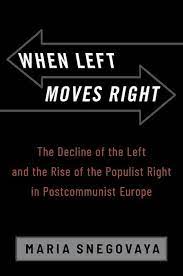When left moves right
the decline of the left and the rise of the populist right in postcommunist Europe
- ISBN: 9780197699034
- Editorial: Oxford University Press
- Fecha de la edición: 2024
- Lugar de la edición: Oxford. Reino Unido
- Encuadernación: Rústica
- Medidas: 24 cm
- Nº Pág.: 320
- Idiomas: Inglés

Over the past two decades, postcommunist countries have witnessed a sudden shift in the electoral fortunes of their political parties: previously successful center-left parties suffered dramatic electoral defeats and disappeared from the political scene, while right-wing populist parties soared in popularity and came to power. This dynamic echoed similar processes in Western Europe and raises a question: Were these dynamics in any way connected? When Right Moves Left argues that they were. And that the root of the connection between them lies in the pro-market rebranding of the ex-communist left--the key explanatory variable. This book asserts that, though the left's pro-market shift initially led to electoral rewards, it had a less straightforward impact on left-wing parties' electoral fortunes in the long run. Traditional supporters of the left (working-class and economically vulnerable groups) were alienated by the new economic policies, and the middle-class voters newly drawn to these parties did not compensate for those losses. As a result, for several electoral rounds following the rebranding, reformist parties on the left suffered dramatic electoral defeats. In response, right-wing parties in their respective countries adopted more redistributive economic platforms consistent with preferences of former supporters of the left, and incorporated sizeable shares of these electorates. This contributed to the growth of right-wing populist parties in the countries with a pro-market left. The book traces this process in postcommunist Europe on different levels of analysis: cross-country observational data, case studies, and individual-level experimental surveys. It argues that scholars should incorporate the economic policy dimension when explaining the demise of the left and the rise of the populist right in the region. It also examines important parallels between the dynamics of Western and postcommunist countries by arguing that the idiosyncrasy of Eastern European politics has been overstated in scholarly literature.
Introduction Chapter 1: How the Left Moved Right Chapter 2. The Class Politics in Postcommunist Europe Chapter 3: How the Postcommunist Left Reformed and Lost Chapter 4: When Left Moves Right, Right Wins Chapter 5: When Left Stays Left, Right Stays Small Chapter 6: Decisions on the Ground: The Experimental Case for a Left-Right Shift References Appendix I. Factor Analysis for Chapter 2 Appendix II. Cross Country Analysis: Left Vote vs Other Parties - Probit Model (Basic) Appendix III. Cross Country Analysis: Left Vote vs Other Parties - Probit Model (controlling for Religiosity and Immigration) Appendix IV. Cross Country Analysis: Left Vote vs Other Parties - Probit Model (controlling for presence of a Radical Right party) Appendix V. Cross Country Analysis: Left Vote vs Other Parties - Multilevel ModelAppendix VI. Cross Country Analysis: Right vs Left Vote - Probit Model Appendix VII. Cross Country Analysis: Right vs Left Vote - Multilevel Model Appendix VIII. Survey Experiment 1: Descriptive Statistics Appendix IX. Survey Experiment 1: Propensity of Voting for Jobbik Appendix X. Survey Experiment 2: Descriptive Statistics Appendix XI. Survey Experiment 2: Propensity of Voting for Jobbik Appendix XII. Elite Interviews






